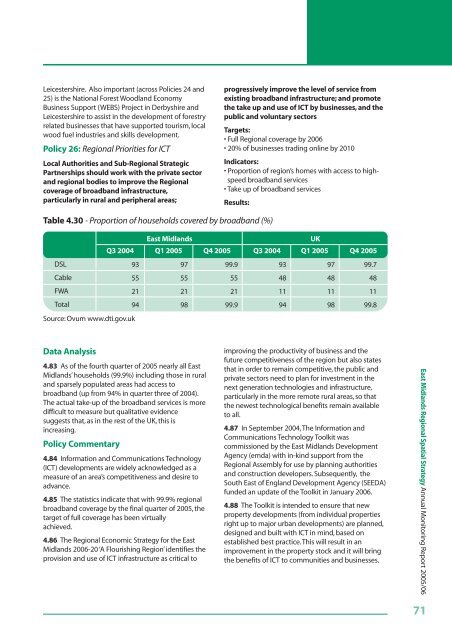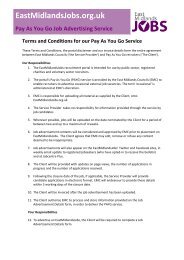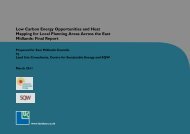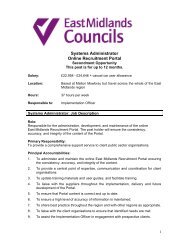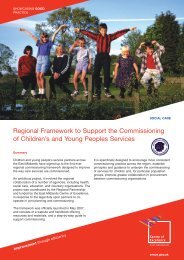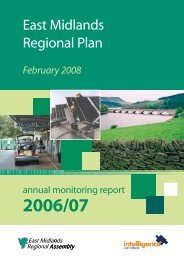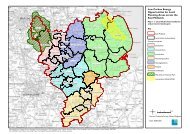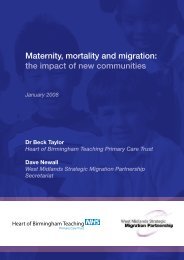East Midlands Regional Spatial Strategy 2005/06
East Midlands Regional Spatial Strategy 2005/06
East Midlands Regional Spatial Strategy 2005/06
You also want an ePaper? Increase the reach of your titles
YUMPU automatically turns print PDFs into web optimized ePapers that Google loves.
Leicestershire. Also important (across Policies 24 and<br />
25) is the National Forest Woodland Economy<br />
Business Support (WEBS) Project in Derbyshire and<br />
Leicestershire to assist in the development of forestry<br />
related businesses that have supported tourism, local<br />
wood fuel industries and skills development.<br />
Policy 26: <strong>Regional</strong> Priorities for ICT<br />
Local Authorities and Sub-<strong>Regional</strong> Strategic<br />
Partnerships should work with the private sector<br />
and regional bodies to improve the <strong>Regional</strong><br />
coverage of broadband infrastructure,<br />
particularly in rural and peripheral areas;<br />
progressively improve the level of service from<br />
existing broadband infrastructure; and promote<br />
the take up and use of ICT by businesses, and the<br />
public and voluntary sectors<br />
Targets:<br />
• Full <strong>Regional</strong> coverage by 20<strong>06</strong><br />
• 20% of businesses trading online by 2010<br />
Indicators:<br />
• Proportion of region’s homes with access to highspeed<br />
broadband services<br />
• Take up of broadband services<br />
Results:<br />
Table 4.30 - Proportion of households covered by broadband (%)<br />
<strong>East</strong> <strong>Midlands</strong><br />
UK<br />
Q3 2004 Q1 <strong>2005</strong> Q4 <strong>2005</strong> Q3 2004 Q1 <strong>2005</strong> Q4 <strong>2005</strong><br />
DSL<br />
Cable<br />
FWA<br />
Total<br />
93<br />
55<br />
21<br />
94<br />
97<br />
55<br />
21<br />
98<br />
99.9<br />
55<br />
21<br />
99.9<br />
93<br />
48<br />
11<br />
94<br />
97<br />
48<br />
11<br />
98<br />
99.7<br />
48<br />
11<br />
99.8<br />
Source: Ovum www.dti.gov.uk<br />
Data Analysis<br />
4.83 As of the fourth quarter of <strong>2005</strong> nearly all <strong>East</strong><br />
<strong>Midlands</strong>’ households (99.9%) including those in rural<br />
and sparsely populated areas had access to<br />
broadband (up from 94% in quarter three of 2004).<br />
The actual take-up of the broadband services is more<br />
difficult to measure but qualitative evidence<br />
suggests that, as in the rest of the UK, this is<br />
increasing.<br />
Policy Commentary<br />
4.84 Information and Communications Technology<br />
(ICT) developments are widely acknowledged as a<br />
measure of an area’s competitiveness and desire to<br />
advance.<br />
4.85 The statistics indicate that with 99.9% regional<br />
broadband coverage by the final quarter of <strong>2005</strong>, the<br />
target of full coverage has been virtually<br />
achieved.<br />
4.86 The <strong>Regional</strong> Economic <strong>Strategy</strong> for the <strong>East</strong><br />
<strong>Midlands</strong> 20<strong>06</strong>-20 ‘A Flourishing Region’ identifies the<br />
provision and use of ICT infrastructure as critical to<br />
improving the productivity of business and the<br />
future competitiveness of the region but also states<br />
that in order to remain competitive, the public and<br />
private sectors need to plan for investment in the<br />
next generation technologies and infrastructure,<br />
particularly in the more remote rural areas, so that<br />
the newest technological benefits remain available<br />
to all.<br />
4.87 In September 2004,The Information and<br />
Communications Technology Toolkit was<br />
commissioned by the <strong>East</strong> <strong>Midlands</strong> Development<br />
Agency (emda) with in-kind support from the<br />
<strong>Regional</strong> Assembly for use by planning authorities<br />
and construction developers. Subsequently, the<br />
South <strong>East</strong> of England Development Agency (SEEDA)<br />
funded an update of the Toolkit in January 20<strong>06</strong>.<br />
4.88 The Toolkit is intended to ensure that new<br />
property developments (from individual properties<br />
right up to major urban developments) are planned,<br />
designed and built with ICT in mind, based on<br />
established best practice.This will result in an<br />
improvement in the property stock and it will bring<br />
the benefits of ICT to communities and businesses.<br />
<strong>East</strong> <strong>Midlands</strong> <strong>Regional</strong> <strong>Spatial</strong> <strong>Strategy</strong> Annual Monitoring Report <strong>2005</strong>/<strong>06</strong><br />
71


